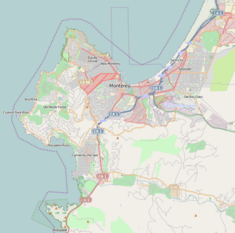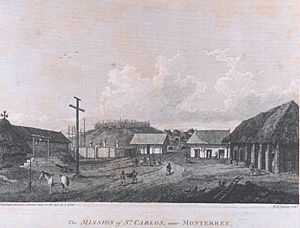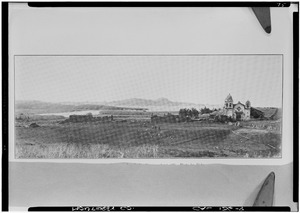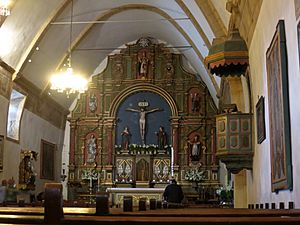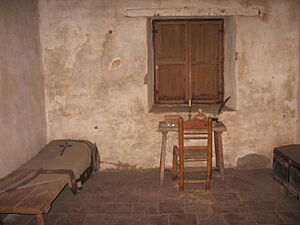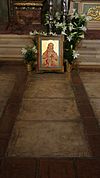Mission San Carlos Borromeo de Carmelo facts for kids
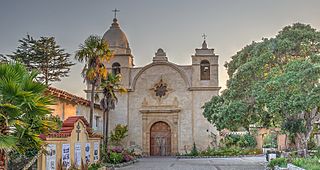
Light-brown-painted façade of capilla (chapel) and tiled and shortened-restored cemetery wall
|
|
| Location | 3080 Rio Road, Carmel-by-the-Sea, California |
|---|---|
| Coordinates | 36°32′34″N 121°55′09″W / 36.54278°N 121.91917°W |
| Name as founded | La Misión San Carlos Borromeo del Río Carmelo |
| English translation | The Mission of Saint Charles Borromeo of the Carmel River |
| Patron | Saint Charles Borromeo |
| Nickname(s) | "Father of the Alta California Missions" |
| Founding date | June 3, 1770 |
| Founding priest(s) | Father Presidente Junípero Serra |
| Founding Order | Second |
| Headquarters of the Alta California Mission System | 1771–1815; 1819–1824; 1827–1830 |
| Military district | Third |
| Native tribe(s) Spanish name(s) |
Esselen, Ohlone Costeño |
| Native place name(s) | Ekheya |
| Baptisms | 3,827 |
| Marriages | 1,032 |
| Burials | 2,837 |
| Secularized | 1834 |
| Returned to the Church | 1859 |
| Governing body | Roman Catholic Diocese of Monterey |
| Current use | Parish Church/Minor Basilica |
| Official name: Carmel Mission | |
| Designated | October 15, 1966 |
| Reference no. | 66000214 |
| Designated | October 9, 1960 |
| Reference no. |
|
| Website | |
| http://carmelmission.org | |
Mission San Carlos Borromeo del Río Carmelo (which means The Mission of Saint Charles Borromeo of the Carmel River in English) is one of the most truly restored old Catholic mission churches in California. It was first built in 1797. You can find it at the mouth of Carmel Valley, California. This mission is a very important historical site, listed on the National Register of Historic Places and recognized as a National Historic Landmark.
From 1797 until 1833, Carmel Mission was like the main office for all the missions in Alta California (which is now California). Junípero Serra, who is now a saint, led the mission from 1770 until he passed away in 1784. It was also the home of the second mission leader, Father Fermín Francisco de Lasuén, who helped finish nine more mission churches.
In 1833, the Mexican government took control of the mission buildings and lands. By the middle of the 1800s, the Carmel Mission buildings were falling apart. The chapel was saved from being completely destroyed when its roof was fixed in 1884. In 1886, the mission was given to the Diocese of Monterey. Since then, Carmel Mission has been a local church within that area.
Starting in 1931, a man named Harry Downie began working to restore the mission. He worked on this project for 50 years! It is the only Spanish mission in California that still has its original bell and bell tower. Carmel Mission also had the first library in the state.
Contents
History of Carmel Mission
Mission Carmel was the second mission built by Franciscan missionaries in Upper California. It was first started as Mission San Carlos Borromeo in Monterey, California on June 3, 1770, by Father Junípero Serra. It was named after Carlo Borromeo, an important church leader from Italy. This mission was also where the first Christian confirmation happened in Alta California.
Moving the Mission to Carmel Valley
Pedro Fages was the military governor of Alta California from 1770 to 1774. He kept his main office at the Presidio of Monterey. Governor Fages was very strict with his soldiers. Father Serra often spoke up for the soldiers, and he and Fages did not get along well. Fages thought the Spanish places in California were mostly for the military, not for religion. The soldiers often treated the native people poorly, which made Father Serra want to move the mission to a safer place for the native community.
Father Serra found that the land at the mouth of Carmel Valley was much better for farming. This is where the Carmel River flows into Carmel Bay. In May 1771, Spain's leader approved Serra's request to move the mission. The mission was set up in its new spot on August 1, 1771. The first church service was held on August 24, and Father Serra officially moved into the new buildings on December 24.
The name of the moved mission became Mission San Carlos Borromeo del Río Carmelo. It was close to the native Rumsen Ohlone villages of Tucutnut and Achasta. The original building in Monterey continued to be used as the Royal Presidio's chapel. It later became the Cathedral of San Carlos Borromeo that you can see today.
Father Serra's Main Office
"Mission Carmel," as it became known, was Father Serra's favorite mission. Because it was near Monterey, the capital of Alta California, he chose it as his main office. When he passed away on August 28, 1784, he was buried under the chapel floor. After Serra's death, Father Fermín Lasuén replaced the old adobe building with a new one made of stone. The stone came from the nearby Santa Lucia Mountains.
Native People and the Mission
After the Carmel mission moved, the Franciscans began to baptize some of the native people. By the end of 1771, the mission had 15 people living there, plus 22 baptized native people.
Farming was difficult at first, and for several years the mission needed supplies to arrive by ship. One historian wrote that in 1773, "Neither Carmel nor Monterey was anything like self-supporting."
To help more people become Christian, the missionaries tried to convert important leaders from the Esselen and Rumsen tribes. On May 9, 1775, Father Junípero Serra baptized the first Esselen person, Pach-hepas. He was the 40-year-old chief of the Excelen tribe. He was near death and was baptized in his home village, about 26 miles southeast of the mission.
Life and Work at the Mission
The Esselen and Ohlone Indians who lived near the mission were baptized. They were then brought to live and work at the mission. Over the years, about 900 Esselen people were baptized and lived at the missions in Carmel Valley, Soledad, and San Antonio. Native people from different tribes lived and worked together at the missions. The native people learned many new skills. They became farmers, shepherds, cowboys, blacksmiths, carpenters, and more. Sadly, many native people died at the missions from disease, hunger, and hard work. The number of native people at Mission San Carlos reached its highest point in 1795 with about 900 people. But by 1823, the number had dropped to 381.
Crops and Animals
In the beginning, the mission relied on bear meat from Mission San Antonio de Padua and supplies brought by ship. By 1779, the native people at Carmel Mission harvested a lot of crops, including wheat, barley, beans, and corn. Four years later, they grew enough food to support 700 people. The mission also had more than 500 cattle and sheep.
Carmel Mission continued to grow throughout the late 1700s. By 1800, farming at Carmel Mission was at its best. The mission reported having 2,180 horses and cattle, and 4,160 smaller animals like sheep. They harvested about 3,700 bushels of grain each year, with a peak of 7,400 in 1797. In December 1832, the mission reported having 2,100 cattle, 3,300 sheep, 410 horses, and 8 mules.
Mission Changes and Abandonment
The Mexican government was worried that the missions were still loyal to the Catholic Church in Spain. In August 1833, the government took control of all the missions and their valuable lands. The government said that half of the mission lands should go to the native people, but this never truly happened. Most of the mission property was bought by government officials or their rich friends. The priests could not keep the missions running without the native people's labor, so the mission and its lands were soon left empty. The native people were forced to leave the mission by the new landowners. Some tried to go back to their old ways of life, while others found work on farms and ranches.
By 1850, the mission was almost completely ruined. The stone chapel building was falling apart, and most of the adobe buildings were washing away. The roof of the chapel collapsed in 1852.
Bringing the Mission Back to Life
When Mexico gave California to the United States after the Mexican–American War in 1848, a treaty said that old land ownership would be respected. The Archbishop Joseph Sadoc Alemany asked for all the former mission lands in California to be returned to the Roman Catholic Church. The state agreed to give back the original mission buildings, cemeteries, and gardens to the church.
When the Roman Catholic Church got full control of the buildings on October 19, 1859, the mission was in ruins. In 1884, Father Angel Casanova raised enough money to replace the chapel roof. This helped save it until the 1930s. In 1931, Monsignor Philip Scher hired a skilled craftsman named Henry John ("Harry") Downie. Harry was known for restoring old Spanish items. Monsignor Scher first asked Harry to fix some statues at the Carmel Mission. But soon, his job grew, and he became in charge of restoring the entire mission. Two years later, the church gave the mission from the Franciscans to the local church area, and it became a regular parish church. Harry Downie lived nearby and worked almost every day for nearly 50 years to restore the mission, its other buildings, walls, and grounds. He carefully studied the church's original design and collected real artifacts from all over California.
He first restored the living quarters for the priests. Then, he fixed the chapel roof in 1936. Over the next five years, he restored the inside of the main church. In 1941, he oversaw the restoration of the old soldiers' quarters. In 1943, he started restoring a building that had been on the south side of the mission. This building was originally a separate dormitory for girls, where they were separated from their families at age 8. Boys and unmarried men also had their own dormitory.
This building was rebuilt and became classrooms for Junipero Serra Elementary School. In 1946, the ruined building on the east side that had been the original kitchen and a blacksmith shop was rebuilt. Today, it is used as a chapel. Harry Downie also helped restore other missions, including San Luis Obispo, San Juan Bautista, and San Buenaventura. He was even honored by the Pope and the King of Spain for his work.
In 1960, Pope John XXIII named the mission a minor basilica, which is a special church. In 1987, Pope John Paul II visited the mission during his trip to the U.S.
The original bell, nicknamed Ave Maria, was made in Mexico City in 1807. It was placed at the Mission in 1820. When the mission was taken over by the government in 1834, the bell was removed and kept safe by local native people. It was lost for a while but found again during the restoration. It was put back in the mission bell tower in 1925.
Carmel Mission Today
Thanks to Harry Downie's hard work, the Carmel mission church is one of the most truly restored mission churches in California. Mission Carmel is recognized as a National Historic Landmark. It is still an active parish church for the Roman Catholic Diocese of Monterey.
Besides being a place of worship, Mission Carmel also hosts concerts, art shows, talks, and many other community events. In 1986, the church got a special organ with unique horizontal trumpets. Its beautiful hand-painted design matches the Spanish style of the main altar.
The mission also works as a museum, keeping its own history and the history of the area alive. There are four different museum areas:
- The Harry Downie Museum, which tells about the restoration work.
- The Munras Family Heritage Museum, which shares the story of an important local family.
- The Jo Mora Chapel Gallery, which shows different art exhibits and a large sculpture by Jo Mora.
- The Convento Museum, which has the cell where Father Serra lived and died, along with other exhibits. One part of the museum has a special chapel room with some of the clothes Father Serra used.
The mission grounds were also home to the Junípero Serra School, a private Catholic school for children from kindergarten to 8th grade. The school opened in 1943 and closed at the end of the 2019–2020 school year.
Ongoing Restoration Work
Between 2000 and 2007, money from private donations helped experts restore the main original Spanish Colonial oil paintings inside the church. One very important painting, called Deposition, was commissioned by Father Serra before he passed away. It now hangs near his tomb in the church.
In 2008, a non-profit group called Friends of Historic Carmel Mission was started. This group helps the church restore and protect the historic landmark. After restoring nine mission bells and many other items, the group became the main funder for restoration and changed its name to the Carmel Mission Foundation.
In 2012, the foundation started a big project to restore the main church, which had not been worked on since 1937 and was considered unsafe. This project was the third major rebuilding of the church since it was first built in 1797. Workers added wood and steel beams to make the roof stronger. To strengthen the thick walls, they drilled holes and put in steel rods. The bell tower dome was also reinforced and cleaned.
The project also updated the electrical system and added a fire safety system. The lights inside were replaced, and special chandeliers were added. Problems with the foundation were fixed, and all the tiles were matched and restored. The heating system was improved, and a restroom that meets Americans with Disabilities Act standards was built. The church restoration was finished in 2013. Over the next few years, the foundation paid for the restoration of many items in the museum and helped protect other historic buildings from decay. This included the Muchado House, built in 1883.
In 2016, the Foundation paid for the restoration of the central courtyard. The old, cracked concrete surface was removed. New water, fire, drain, sewer, electrical, and communication lines were installed. Then, a stronger concrete surface was poured to match the original one from the 1960s.
The courtyard fountain was also restored. The large barbecue pits, used for community barbecues since 1913, were reinforced and updated. The gardens were replanted with native plants, and new outdoor lighting was installed. The foundation also created the Serra Memorial Circle in the Courtyard to honor people who donated money.
The foundation worked with the Mission Docent Association to preserve the Our Lady of Bethlehem statue, which is thought to be one of the oldest statues in California. In 2020, the front perimeter wall started to fall apart. The foundation paid to remove the old wall and build a temporary one until a permanent one can be designed and built.
In late 2020, The Carmel Mission Foundation began a project to restore and make the old Downie Museum stronger against earthquakes. This work is happening in time to celebrate the 250th anniversary of the Carmel Mission's founding. The restoration removed restrooms from the back of the building, making the museum's inside space twice as big. Paint covering the stone around the fireplace, installed in 1920, was removed.
The foundation is still looking for more money to pay for earthquake safety upgrades, other building improvements, and the restoration of the Mora Museum, Convento Museum, Blessed Sacrament Chapel, and the historic Orchard House Property.
Folklore and Legends
The stories of the Lost Padre Mines of the Carmel Mission are a big part of local legends. These tales suggest that native communities knew about lots of gold hidden in the wild Santa Lucia Mountains. As these stories were passed down, the mysterious Lost Padre Mines became a symbol of hidden treasures and the lasting magic of the land. Many of these legends seem to have come from people who lived in Carmel Valley for a long time. It is possible that some of the last descendants of the Mission Indians, who lived and worked in the area, helped these stories grow.
Vandalism at the Mission
On September 27, 2015, the San Carlos Borromeo de Carmelo Mission was vandalized. This happened after Father Serra was made a saint. The statue of Serra was pushed over and splattered with paint. The cemetery, the mission doors, a fountain, and a crucifix were also vandalized. The words "Saint of Genocide" were painted on the ground, and similar messages were painted in other parts of the mission courtyard.
Important People Buried Here
Several important people are buried in the church and churchyard, which is known as the Carmel Mission Cemetery.
- Juan Crespí (1721–1782), a Spanish missionary and explorer.
- Fermín Lasuén (1736–1803), a Spanish missionary and explorer.
- José Antonio Roméu, (1742? – 1792) a Spanish governor of California.
- Junípero Serra (1713–1784), the founder of the Spanish missions in California and a saint.
See also
 In Spanish: Misión San Carlos Borromeo de Carmelo para niños
In Spanish: Misión San Carlos Borromeo de Carmelo para niños
- Spanish missions in California
- List of Spanish missions in California
- Cathedral of San Carlos Borroméo (also known as Royal Presidio Chapel), Monterey, California
- USNS Mission Carmel (AO-113), a ship built during World War II.
- USNS Mission San Carlos (AO-120), another ship built during World War II.


